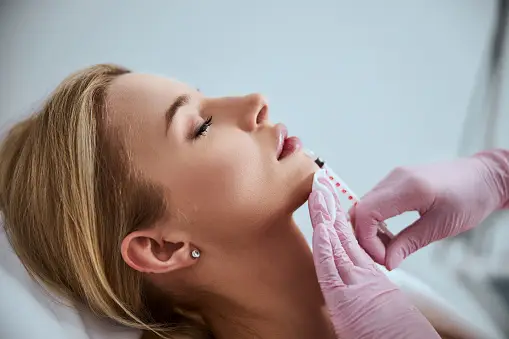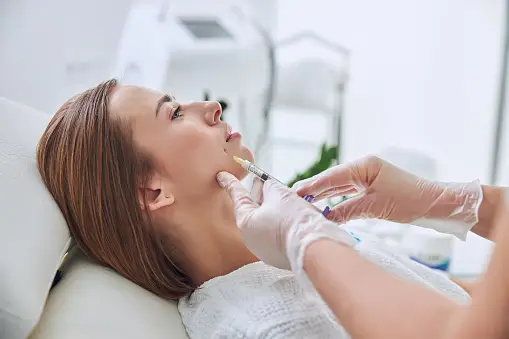Dermal fillers are a popular cosmetic procedure used to enhance facial features, reduce the appearance of wrinkles, and restore volume to the skin. While they can provide effective results when performed by qualified professionals, it is important to be aware of potential risks and considerations before undergoing treatment. Here are some points to keep in mind:
- Choosing a Qualified Practitioner: To minimize risks, it is crucial to select a qualified and experienced medical professional who specializes in administering dermal fillers. Ideally, this should be a licensed dermatologist or plastic surgeon who has undergone proper training.
- Potential Side Effects: Like any medical procedure, dermal fillers carry some risks. Common side effects may include temporary redness, swelling, bruising, and itching at the injection site. These typically subside within a few days. However, more serious complications such as infection, tissue damage, or allergic reactions are possible, albeit rare.
- Allergic Reactions: Although uncommon, some individuals may experience an allergic reaction to the filler substance. It is essential to inform your practitioner about any known allergies or sensitivities to avoid complications.
- Temporary Results: Dermal fillers offer temporary results, typically lasting between 6 months to 2 years, depending on the product used. Regular maintenance sessions are necessary to maintain the desired effect.
- Overfilling and Unnatural Results: Overfilling or improper injection technique can lead to unnatural-looking results. It is important to communicate your expectations clearly with your practitioner and work together to achieve a natural and balanced outcome.
- Individual Variations: Each person’s anatomy and skin condition are unique, meaning that the results of dermal fillers can vary from person to person. It is essential to have realistic expectations and understand that the outcome may not be the same as someone else’s.
- Long-Term Effects: The long-term effects of repeated dermal filler treatments are not extensively studied. It is crucial to discuss potential long-term implications with your practitioner, especially if you are considering multiple treatments over an extended period.
- Other Treatment Options: Dermal fillers are just one approach to facial rejuvenation. There are alternative treatments available, such as botulinum toxin injections (e.g., Botox) or surgical procedures. Consulting with a qualified professional will help you determine the most suitable option for your specific needs.
It is important to conduct thorough research, consult with a reputable practitioner, and have a detailed discussion about the benefits, risks, and alternatives before deciding to undergo dermal filler treatment.

What is the difference Botox and dermal fillers?
Botox and dermal fillers are both popular cosmetic treatments used to reduce the signs of aging and enhance facial appearance. However, they work in different ways and target different concerns. Here are the main differences between Botox and dermal fillers:
Botox (Botulinum Toxin):
- Mechanism of Action: Botox is a purified form of botulinum toxin that is injected into specific muscles to temporarily paralyze or relax them. It works by blocking the nerve signals that cause muscle contractions, thereby reducing the appearance of wrinkles and fine lines caused by repetitive facial movements.
- Purpose: Botox is primarily used to treat dynamic wrinkles, which are wrinkles that form due to muscle movement, such as frown lines between the eyebrows, forehead lines, and crow’s feet around the eyes. It is not typically used to add volume to the face.
- Results: The effects of Botox typically take a few days to appear and gradually improve over the course of one to two weeks. The results can last three to four months, after which the treatment can be repeated to maintain the effects.
Dermal Fillers:
- Mechanism of Action: Dermal fillers are injectable substances that add volume and fill in lines, wrinkles, and hollow areas of the face. They work by physically filling the area under the skin, plumping it up and smoothing out wrinkles and folds.
- Purpose: Dermal fillers are primarily used to restore volume, contour the face, and minimize the appearance of wrinkles and lines. They are commonly used to treat static wrinkles, which are present even when the face is at rest, and to enhance features like the cheeks, lips, and jawline.
- Results: The results of dermal fillers are typically immediate, although there may be some swelling and bruising initially. The duration of the results depends on the type of filler used, but it can range from several months to a couple of years. Maintenance treatments are usually required to sustain the desired effects.
It’s worth noting that while both Botox and dermal fillers are minimally invasive procedures, they target different aspects of facial aging. Depending on your specific concerns and goals, a combination of both treatments may be recommended by a qualified practitioner to achieve comprehensive facial rejuvenation. Consulting with a medical professional will help determine the most suitable treatment plan for you.
Is filler safer than Botox?
Both dermal fillers and Botox are considered safe when administered by qualified professionals. However, it’s important to note that each treatment carries its own set of risks and considerations. Here’s an overview of the safety aspects of both treatments:
Dermal Fillers:
- Safety: Dermal fillers are generally safe when used appropriately. The most commonly used fillers are made of biocompatible materials, such as hyaluronic acid, which is naturally found in the body. Allergic reactions to dermal fillers are rare but possible.
- Risks: Like any medical procedure, dermal fillers carry some risks. Possible risks and complications include infection, bruising, swelling, asymmetry, lumps, and rare but serious complications such as vascular occlusion (blockage of blood vessels) or tissue damage. These risks can be minimized by choosing a qualified practitioner and following proper injection techniques.
- Reversibility: One advantage of certain dermal fillers, particularly those made of hyaluronic acid, is that they can be partially or completely reversed using an enzyme called hyaluronidase. This provides an added safety measure in case of dissatisfaction or adverse events.
Botox:
- Safety: Botox has a long history of safe use when administered correctly. It is derived from the botulinum toxin type A, but the formulation used for cosmetic purposes is highly purified and approved by regulatory authorities.
- Risks: Common side effects of Botox injections are generally mild and temporary, including redness, bruising, headache, and temporary weakness or drooping of nearby muscles. However, more serious complications, although rare, can occur, such as infection, allergic reactions, or asymmetry if not properly administered.
- Long-Term Safety: The long-term effects of regular and repeated Botox injections over many years are not extensively studied. While there is no evidence to suggest significant long-term safety concerns, it’s important to discuss any potential risks or concerns with your practitioner.
In both cases, it is crucial to choose a qualified medical professional who has experience in administering the treatment and follows proper injection techniques. They will conduct a thorough assessment of your medical history and discuss potential risks and benefits before proceeding with the treatment.
Ultimately, the safety of dermal fillers and Botox depends on the skill and expertise of the practitioner, adherence to best practices, and open communication between you and your provider.
What is the safest filler for face?
The safety of dermal fillers depends on various factors, including the type of filler used, the skill and experience of the practitioner, and individual factors such as medical history and allergies. However, among the different types of dermal fillers available, hyaluronic acid (HA) fillers are generally considered to be one of the safest options. Here’s why:
- Biocompatibility: Hyaluronic acid is a substance naturally found in the human body, specifically in the skin, joints, and connective tissues. HA fillers are synthesized to mimic the body’s own hyaluronic acid, making them biocompatible and less likely to cause allergic reactions or adverse effects.
- Reversibility: One significant advantage of HA fillers is that they can be partially or completely reversed using an enzyme called hyaluronidase. If needed, the practitioner can inject hyaluronidase to break down the HA filler, providing a means to correct any undesirable outcomes or manage complications.
- Versatility: HA fillers offer versatility in terms of customization and results. The consistency and texture of HA fillers can be adjusted, allowing for precise placement and contouring of the treated areas. This versatility helps achieve natural-looking results.
- Established Safety Profile: HA fillers have been widely used for many years and have an established safety profile. Extensive research, clinical trials, and real-world experience support their safety and efficacy.
While HA fillers are generally considered safe, it’s important to remember that the safety and success of the procedure also depend on the practitioner’s skill and expertise. Choosing a qualified and experienced medical professional who specializes in cosmetic injectables is crucial to minimize risks and ensure the best possible outcomes.
During your consultation, the practitioner will assess your individual needs, discuss potential risks and benefits, and recommend the most suitable filler for your specific goals and concerns. They will also consider factors such as your skin type, desired results, and any existing medical conditions to determine the best approach for you.
